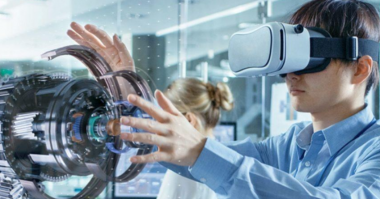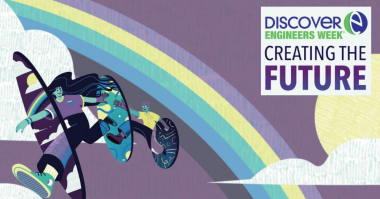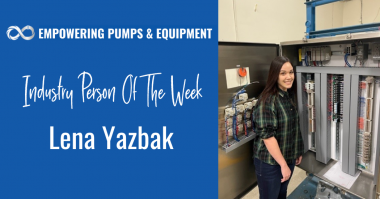3D Inverse Design Technology
What is Inverse Design?
Unlike the conventional or direct approach, where the geometry is changed iteratively by using the application of CFD analysis methods and through trial and error until the optimum flow conditions are obtained, with the Inverse approach the geometry is computed for a specified optimum flow distribution, where the loading distribution is specified and then the blade geometry is computed, this approach is much quicker in generating the blade geometry. The inverse approach has been used previously using 2D methods, with the surface velocity specified, but these methods offered no control over blade thickness and it was difficult to ensure structural integrity and difficult to apply in 3D because of hub to shroud compatibility conditions. Other areas of development in the Inverse method include stating the velocity on one surface and blade thickness, but it is difficult to apply in 3D because of hub to shroud compatibility conditions. It was only when the blade loading, blade distribution and blade thickness parameters were entered as an input requirement that the Inverse approach ensured a design that not only satisfied structural considerations, but could be applied in 3D and allowed the possibility to design for a fixed Euler work.
What type of Turbomachinery can be designed using the Inverse Design methodology found in the TURBOdesign family?
The two codes can be used in many industries and applicable to all types of turbomachinery including Compressible or Incompressible flow, Radial, mixed, and axial-flow machines, Rotational or Stationary and Turbine flow or Pump flow.
What are the advantages and benefits of TD1?
TURBOdesign1 enables the control of 3D pressure fields through the loading distribution, thereby allowing the user to address flow features such as secondary flows and 3D flow separation in a direct manner. It has lead to breakthrough designs in many Turbomachinery applications. Its benefits are as follows:
- Full 3D Inverse method.
- Complete control of 3D pressure fields through blade loading.
- Innovative design beyond previous experience.
- Easy to export the resulting geometry to major CFD, CAD and FEA system.
- Valuable manpower and design time savings.
- Easy to generate database of design know how.
- Logical feedback of CFD results to design inputs.
- Direct portability of design inputs from one design to another.
Why do you specify blade loading?
In the past many types of design specifications have been employed. Many of the early 2D methods used blade surface pressure on both surfaces. However, such an approach has server limitation as the blade thickness can not specified and in many cases it is impossible to ensure the closure of the blade. Alternative approaches to get round this problem has been based on the specification of the blade pressure distribution on one surface, normally the suction surface, and the blade thickness. However, both of these approaches cannot be readily applied in 3D as the pressure distribution at each streamline is dependent on the streamline patterns and the distribution of pressure at other streamwise sections. This so called compatibility condition means that methods based on specification of surface pressure on either one or two blade surfaces may not always provide a solution for a specified pressure distribution. In TURBOdesign1 and Method 1 of TURBOdesign2, the blade loading or meridional derivative of rVθ is specified together with blade thickness. This provides a number of advantages. Firstly the method can be applied in a robust and consistent manner in 3D. Also the blade loading is directly related to pressure jump across the blade and hence one can have control over the 3D pressure field. In addition the area under the blade loading diagram for each streamwise section is directly related to the specific work and hence once can implicitly ensure that the blade is designed for a given specific work.
How can you find the optimized blade loading?
The process of finding the optimum blade loading in many problems can start by considering the results of a CFD computation of an equivalent conventionally designed blade row. By detailed study of the flow field in the blade one can understand the main flow mechanism, which generate most of the loss. For example it could be flow separation, secondary flows, shock waves, tip clearance etc. Appropriate choice of blade loading can then help to minimize losses. For example to control tip clearance in centrifugal compressor an aft-loaded distribution can be beneficial as it is important to reduce tip clearance in the inducer section of the impeller. One important aspect of the design is that once the optimum blade loading for a particular type of machine if found the results are quite general and can be applied with ease to machine of similar type.
What are the main parameters required to be input, for this inverse approach?
The main input parameters are Rotating Speed, Inlet Flow Distribution (which are specified), the Meridional Profile, Blade Number and Blade Thickness (which are assumed based on experience and structural strength) with the most important parameters being the Blade Loading and the Stacking Condition, (which are specified). Any assumed data may be optimized separately once other parameters are optimized.
Is it possible to impose geometric constraints?
The current version of TURBOdesign1 does not allow users to directly specify geometric constraints. However, there are a number of ways in which the blade geometry can be simplified by the choice of the blade loading specification. ADT has developed considerable know-how in this area which it shares with its customers.
How do you ensure structural integrity in the design?
In TURBOdesign1 it is possible to specify the normal thickness which in most cases should help to ensure the structural integrity of the design. However in some cases TURBOdesign1 and TURBOdesign2 can create complicated 3D blade geometries. Care should be taken in the choice of blade loading and stacking conditions in order to minimize bending stresses. ADT has developed considerable amount of know-how in this area which is made available to customers of TURBOdeisgn1 and TURBOdesign2. Also the blade geometry can be easily exported to FEA codes through the IGES and STL file formats for detailed analysis of the stress and vibration characteristic of the designed blade.
How can you export geometry to and from CFD and CAD?
TURBOdesign1 has the functionality to convert the geometry data from inverse design to other CFD, structural analysis or CAD software. The following file conversions are supported:
- IGES
- Plot3D
- STL
- Fluent G/Turbo
- CFX BladeGen
- CFX TurboGrid
- Dawes
- VRML
- Es Turbo (STARCD)
NOTE: TURBOdesign1 is an inverse design software for turbomachines in which the 3D blade geometry will be calculated inversely from the specified loading distribution, and it doesn’t have the functionality for the performance prediction and CFD analysis capability. However TURBOdesign1 not only computes the blade geometry but it also provides very accurate predictions of the 3D inviscid pressure field, which compares quite well with the corresponding predictions of the blade surface pressure distribution. TURBOdesign2 essentially has the capability to solve 3D flow field using 3D Euler solver including viscous effects as other CFD codes. Users can analyze the flow field and performance of the existing blade. However, the most important feature of TURBOdesign2 is its 3D inverse design capability to design the blade geometry to realize the specified loading distribution. Existing CFD code can analyze the flow filed in the turbomachinery but never suggest the direction of the blade geometry modification from the results.
10) How can you exploit existing design database and R&D information into TURBOdesign1 and TURBOdesign2?
Existing database should be the good start point for the inverse design. User can use existing meridional geometry, thickness distribution and design work requirement from the existing experimental or analysis results. Also the loading distribution of existing designs can be obtained from CFD computations and used as a starting point in the choice of blade loading when using TURBOdesign1.
About the Author:
Mehrdad Zangeneh is professor of thermofluids at University College London and founding director of ADT. For 26 years, Zangeneh has developed advanced turbomachinery design codes based on the 3D inverse design approach and automatic optimization to turbomachinery design. His research has resulted in important breakthroughs in turbomachinery and marine propulsor design, and he has been granted six international patents. In 2000, Zangeneh was awarded the Japan’s Turbomachinery Society’s Gold Medal, and in 2003 he was awarded the Donald Julius Grone Prize by the Institution of Mechanical Engineers in UK.




Good post. I’m going through many of these issues as well..